India's wildlife sanctuaries are a treasure trove of animal life, drawing visitors worldwide. From majestic tigers to one-horned rhinos and vibrant birdlife, these sanctuaries offer an unforgettable experience. Here's your one-stop guide to top 15 national parks and wildlife sanctuaries in India. We'll explore the best parks for spotting tigers, the ideal times to visit, and provide helpful tips on getting there. We've even curated links to India's best wildlife tour packages for your convenience. Have questions about your upcoming wildlife safari? Don't hesitate to ask – we're here to help you plan your dream adventure. So, buckle up and get ready to embark on a wild journey through the most incredible wildlife sanctuaries in India!
15. Bhadra Wildlife Sanctuary: Karnataka's Gem
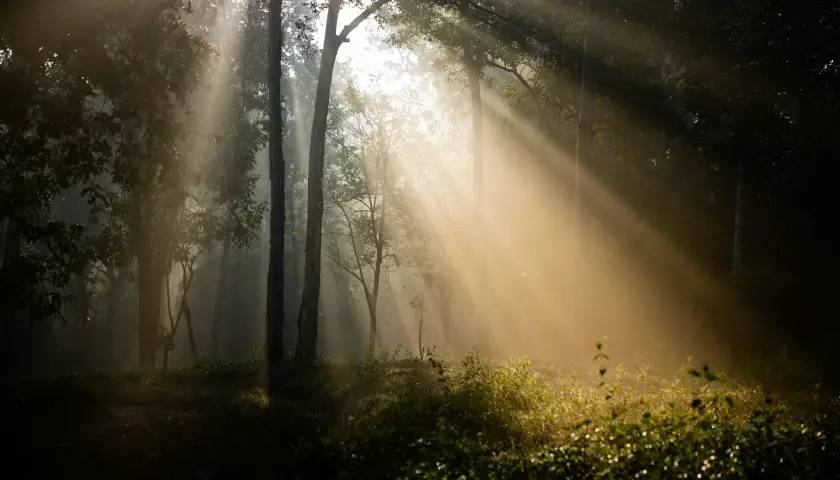
Nestled in the Western Ghats of Karnataka, Bhadra Wildlife Sanctuary is a haven for wildlife enthusiasts. This protected area, designated as a Project Tiger reserve, boasts a rich tapestry of flora and fauna. Located just south of Bhadravathi town and northwest of Chikkamagalur, Bhadra is a popular choice for day trips, offering a glimpse into India's incredible biodiversity.
The Flora at Bhadra Wildlife Sanctuary: Over 120 plant species thrive within Bhadra's boundaries. The dominant trees include teak, rosewood, and axlewood, creating a quintessential dry deciduous forest. Climbers like creep myrtle (lanceolata) add vibrant splashes of color, while fig trees and mango trees provide sustenance for herbivores. The sanctuary also boasts thorny and clumping bamboo, offering shelter and nesting sites for various birds and mammals.
The Fauna of Bhadra Wildlife Sanctuary: Bhadra's animal kingdom is a sight to behold. The star attraction, of course, is the majestic tiger, with an estimated population of 33 individuals. But the show doesn't stop there. Leopards, including the melanistic black panther, prowl through the dense foliage. Gaur, the largest wild bovine in Asia, graze alongside elephants and sloth bears. Wild boar, spotted deer, and sambar deer provide prey for these apex predators. For a closer look at smaller mammals, keep an eye out for langurs, macaques, slender lorises, and even the elusive Malabar giant squirrel. Bhadra's avian population is equally impressive, with over 250 species recorded. Be sure to listen for the calls of the paradise flycatcher, the greater racket-tailed drongo, and the Malabar trogon. Reptiles like monitor lizards, mugger crocodiles, and a variety of snakes add another layer of intrigue to Bhadra's ecological tapestry.
Best Time to visit Bhadra Wildlife Sanctuary: The ideal time to visit Bhadra Wildlife Sanctuary is between October 1st and June 30th. During these months, the weather is pleasant, and the forests are teeming with life. However, the park is closed to visitors from July to September due to the monsoon season.
Safari timings at Bhadra Wildlife Sanctuary:
Daily Safaris: Monday / Tuesday / Wednesday / Thursday / Friday / Saturday / Sunday
- Morning Safari: 6:30 am - 8:30 am
- Evening Safari: 4:00 pm - 6:00 pm
You might also like Top 10 National Parks in India
14. Dudhwa National Park, Uttar Pradesh

Adventure awaits in Dudhwa National Park, a hidden gem bordering Nepal in Uttar Pradesh. This tiger reserve isn't just about spotting majestic Royal Bengal tigers; it's a haven for diverse wildlife. Imagine spotting elusive leopards, or be captivated by the comical sloth bear or graceful black buck. Dudhwa boasts over 450 bird species, making it a paradise for birdwatchers. The park's diverse landscapes – wetlands, grasslands, and dense forests – provide a habitat for a remarkable array of creatures, from the endangered flying fox to prehistoric crocodiles. Plan your trip between October and June to experience the thrill of a jeep safari and witness the untamed beauty of Dudhwa.
The Flora at Dudhwa National Park: The Park flourishes with a diverse range of plant life. The park's dominant tree species is the Sal, forming dense forests that provide crucial shelter for the wildlife. Other prominent trees include Asna, a large deciduous tree offering shade and food for herbivores, Shisham, a fast-growing tree with timber value but also an important source of sustenance and habitat for animals, Jamun, a common fruit tree with dark purple berries enjoyed by wildlife, and Gular, a large deciduous tree with distinctive red flowers that serve as nesting sites for birds.
The Fauna of Dudhwa National Park: The park is a tapestry of captivating creatures. The park is most renowned for the majestic Royal Bengal Tiger, with Dudhwa being one of their last remaining strongholds in Uttar Pradesh. Sharing the spotlight are elusive leopards, often spotted camouflaged within the dense forests. Dudhwa is also home to the Swamp Deer, the largest deer species in India with impressive antlers. Other fascinating mammals include the comical sloth bear, the graceful black buck antelope found in the park's grasslands, the endangered Indian flying fox with its impressive wingspan, and the prehistoric-looking snub-nosed marsh crocodile basking in the freshwater marshes. Over 450 species of birds call Dudhwa home, from the vibrant calls of peacocks to soaring eagles. The park's diverse landscapes provide a habitat for a variety of reptiles, insects, and even more mammal species, making Dudhwa a haven for nature enthusiasts.
Best time to visit Dudhwa National Park: Exploring Dudhwa National Park on a thrilling jeep safari is best between November and April. The park undergoes a seasonal closure during the monsoon season (July to September) to allow for rejuvenation and breeding. During the dry season (October to June), temperatures are pleasant, ranging from cool mornings to warm afternoons, making it perfect for outdoor activities like jeep safaris. Additionally, the sparse vegetation during this dry period enhances your chances of spotting elusive animals. So, pack your binoculars, camera, and sense of adventure for an unforgettable encounter with Dudhwa's wonders during the dry season.
Safari timings at Dudhwa National Park:
Daily Safaris: Monday / Tuesday / Wednesday / Thursday / Friday / Saturday / Sunday
- Morning Safari: 6:00 am - 9:30 am
- Evening Safari: 3:00 pm - 6:00 pm
13. Dandeli Wildlife Sanctuary, Karnataka
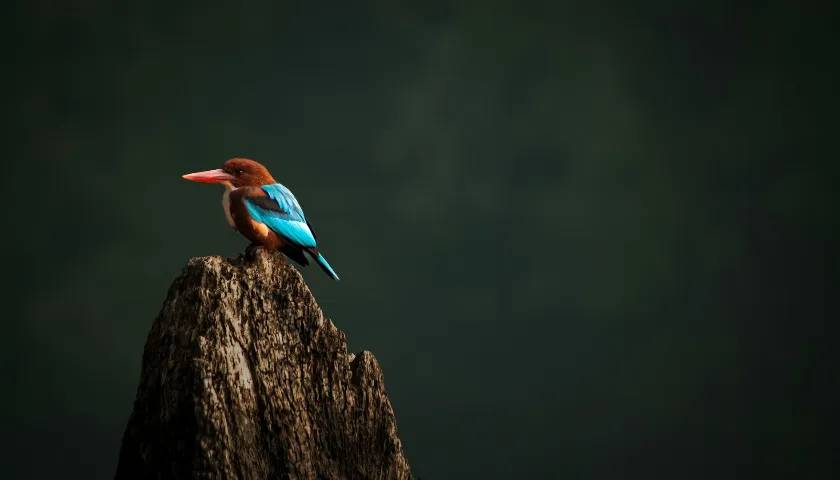
Nestled in the Western Ghats of Karnataka, India, Dandeli Wildlife Sanctuary is a haven for nature enthusiasts and adventure seekers alike. Spanning over 834.16 square kilometers, this sanctuary is the second-largest in Karnataka and boasts a rich biodiversity. Home to a variety of wildlife, including tigers, leopards, black panthers, elephants, and the elusive Indian pangolin, it provides an exciting glimpse into the region's vibrant ecosystem. Adventure enthusiasts can indulge in activities like white-water rafting on the Kali River, trekking, and jungle safaris. The Kavala Caves, with their ancient limestone formations, add a touch of historical intrigue to the sanctuary's natural beauty. Dandeli Wildlife Sanctuary, with its blend of wildlife, adventure, and tranquility, offers a perfect escape from the hustle and bustle of city life, making it a must-visit destination for nature lovers.
Flora at Dandeli Wildlife Sanctuary: Dandeli Wildlife Sanctuary's flora is a vibrant tapestry of diverse plant life, primarily composed of deciduous and semi-evergreen forests. The sanctuary is characterized by towering teak and bamboo trees, interspersed with clusters of eucalyptus, silver oak, and a variety of medicinal plants. The dense undergrowth is rich with shrubs, creepers, and an array of colorful wildflowers that bloom throughout the year. This lush vegetation not only provides a picturesque landscape but also serves as a vital habitat for the sanctuary's fauna, offering food, shelter, and breeding grounds. The thick forest canopy and diverse plant species create a unique microclimate, fostering an environment conducive to the thriving biodiversity of the region.
Fauna at Dandeli Wildlife Sanctuary: The fauna of Dandeli Wildlife Sanctuary is equally impressive, showcasing a rich array of wildlife. The sanctuary is home to large predators like tigers, leopards, and black panthers, alongside herbivores such as elephants, gaur, and deer. Smaller mammals like the Indian pangolin, sloth bear, and various species of bats add to the sanctuary's diversity. Birdwatchers will be delighted by the presence of over 200 bird species, including the majestic great hornbill, Malabar pied hornbill, and a variety of kingfishers and woodpeckers. Reptiles, too, find a haven here, with the presence of crocodiles in the Kali River and numerous species of snakes and lizards throughout the forest. This diverse array of fauna makes Dandeli Wildlife Sanctuary a crucial conservation area and a fascinating destination for wildlife enthusiasts.
Best time to visit Dandeli Wildlife Sanctuary: The best time to visit Dandeli Wildlife Sanctuary is from October to March, when the weather is pleasant and ideal for outdoor activities. During these months, temperatures range from 14°C to 30°C, providing a comfortable climate for wildlife spotting, trekking, and birdwatching. The post-monsoon greenery enhances the sanctuary's natural beauty, making it a perfect time for photography and exploring the lush landscapes. Additionally, the cooler temperatures are favorable for adventure activities like white-water rafting on the Kali River. Visiting during this period ensures a delightful and immersive experience in the sanctuary's rich biodiversity without the challenges of extreme heat or heavy rainfall.
Safari timings at Dandeli Wildlife Sanctuary:
Daily Safaris: Monday / Tuesday / Wednesday / Thursday / Friday / Saturday / Sunday
- Morning Safari: 6:00 am - 8:00 am
- Evening Safari: 4:00 pm - 6:00 pm
12. Panna National Park, Madhya Pradesh
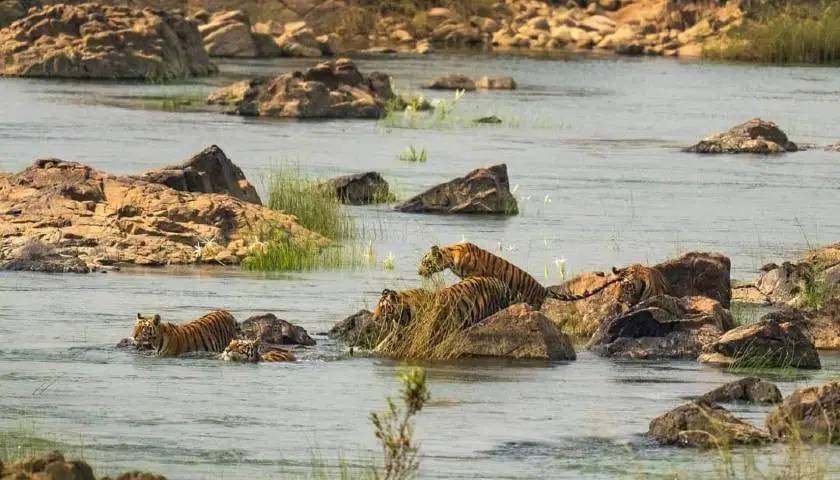
Panna National Park, ranked 12th, is celebrated for its dramatic landscapes and successful tiger conservation efforts. Situated in Madhya Pradesh, this park boasts a diverse range of flora and fauna, including tigers, leopards, and gharials, thriving in its teak and mixed forest ecosystem. The Ken River, flowing through the park, adds to its scenic beauty and supports a variety of aquatic life. Panna's success story in tiger reintroduction and conservation has garnered national and international acclaim, making it a model for wildlife preservation. The park's rich biodiversity, combined with its striking gorges, waterfalls, and the ancient Pandav Falls, offers an exceptional experience for nature enthusiasts. This blend of natural splendor and conservation achievement rightfully secures Panna National Park the 12th rank on our list.
Flora at Panna National Park: Panna National Park boasts a diverse range of flora, typical of the dry deciduous forests of central India. The landscape is dominated by tropical dry mixed forests, interspersed with open grasslands and rocky hills. The park's vegetation includes tall teak trees, sal, mahua, tendu, and bamboo groves, creating a rich and varied habitat for wildlife. During the monsoon season, the park transforms into a lush green paradise, providing ample forage and shelter for its inhabitants.
Fauna at Panna National Park: Panna National Park is renowned for its thriving wildlife population, including a significant number of tigers. Besides tigers, the park is home to leopards, sloth bears, Indian wolves, striped hyenas, and several species of deer such as chital, sambar, and nilgai. It also hosts smaller carnivores like jungle cats, wild dogs, and foxes. The park's rivers and water bodies support a variety of aquatic species, including the endangered gharial and mugger crocodiles. Panna is also a haven for birdwatchers, with over 200 species of resident and migratory birds, including the stunning paradise flycatcher and the elusive Indian vulture. The diverse flora and fauna of Panna National Park offer visitors a memorable and enriching wildlife experience in the heart of Madhya Pradesh.
Best time to visit Panna National Park: The best time to visit Panna National Park is from October to April, during the cooler and drier months of the year. This period, especially from November to March, offers the most favorable weather for wildlife viewing and safaris. The vegetation is relatively sparse, making it easier to spot animals gathering around water sources. Moreover, this time coincides with the migratory bird season, enhancing the park's biodiversity and offering excellent opportunities for birdwatching enthusiasts. It's advisable to avoid the monsoon season (July to September) when heavy rainfall can lead to park closures and difficult safari conditions due to muddy roads.
Safari timings at Panna National Park:
Daily Safaris: Monday / Tuesday / Wednesday / Thursday / Friday / Saturday / Sunday
Summer (March to June):
- Morning Safari: 6:00 AM to 11:00 AM
- Evening Safari: 3:00 PM to 6:30 PM
Winter (October to February):
- Morning Safari: 6:30 AM to 10:00 AM
- Evening Safari: 2:00 PM to 5:30 PM
11. Pench National Park, Madhya Pradesh
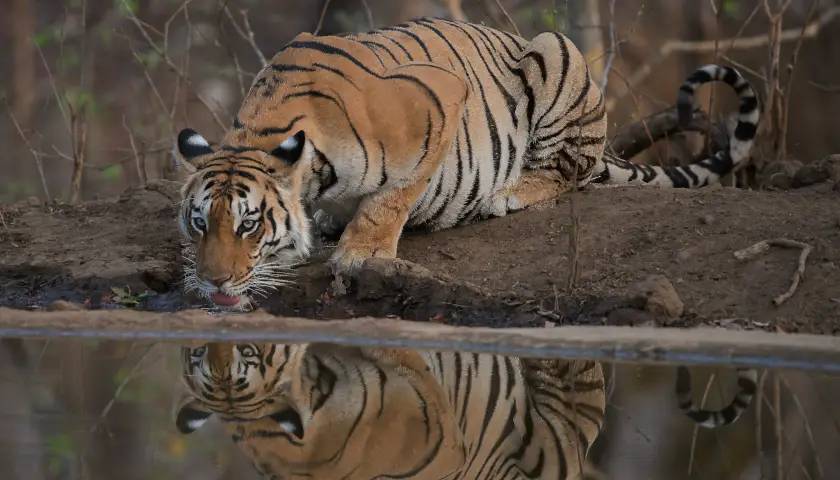
Pench National Park, ranked 11th on our list of "Top 15 Wildlife Sanctuaries in India," earns its spot due to its remarkable biodiversity and historical significance. Spanning the states of Madhya Pradesh and Maharashtra, Pench is renowned for its thriving population of tigers, leopards, and Indian bison, making it a premier destination for wildlife enthusiasts. The park's rich flora, including teak and bamboo forests, creates a picturesque and lush habitat that supports a wide array of fauna. Pench's fame is further bolstered by its association with Rudyard Kipling's classic "The Jungle Book," bringing an enchanting literary charm to its natural beauty. The well-maintained safari trails and effective conservation efforts enhance the visitor experience, making Pench a noteworthy sanctuary that perfectly fits the 11th rank on our list.
Flora at Pench National Park: Pench National Park, straddling the states of Madhya Pradesh and Maharashtra, is characterized by its tropical dry deciduous forests and lush teak woodlands. The park's landscape is primarily dominated by majestic teak trees, accompanied by other significant species such as mahua, tendu, Indian gooseberry, and bamboo groves. The undulating terrain and seasonal streams contribute to a diverse array of plant life, providing ample forage and shelter for the park's wildlife. During the post-monsoon period, the forest comes alive with vibrant greenery, enhancing the park's scenic beauty and ecological richness.
Fauna at Pench National Park: Pench National Park is renowned for its rich and diverse fauna, most famously its thriving tiger population, which inspired Rudyard Kipling's "The Jungle Book." Besides tigers, the park is home to leopards, wild dogs (dholes), sloth bears, and a variety of herbivores including chital, sambar, nilgai, and Indian gaur. The park's rivers and reservoirs attract a multitude of bird species, making it a paradise for birdwatchers with over 250 recorded species, including the crested serpent eagle, white-eyed buzzard, and Malabar pied hornbill. Pench's diverse habitats and well-protected environment support a vibrant ecosystem, offering visitors a captivating wildlife experience.
Best time to visit Pench National Park: The best time to visit Pench National Park is from October to February, during the winter and early spring months. This period offers pleasant weather with cooler temperatures, making it ideal for wildlife safaris and outdoor activities. The vegetation is less dense, improving visibility for spotting animals congregating around water sources. Additionally, birdwatching enthusiasts will find this time particularly rewarding as many migratory bird species visit the park during the winter months. It's advisable to avoid the monsoon season (July to September) when heavy rains can lead to road closures and limited safari opportunities due to muddy conditions.
Safari timings at Pench National Park: Daily Safaris: Monday / Tuesday / Wednesday / Thursday / Friday / Saturday / Sunday
Summer (April to June):
- Morning Safari: 6:30 am - 9:30 am
- Evening Safari: 4:00 PM to 6:30 PM
Winter (October to March):
- Morning Safari: 7:30 am - 10:30 am
- Evening Safari: 3:00 PM to 5:30 PM
10. Nagarhole National Park, Karnataka
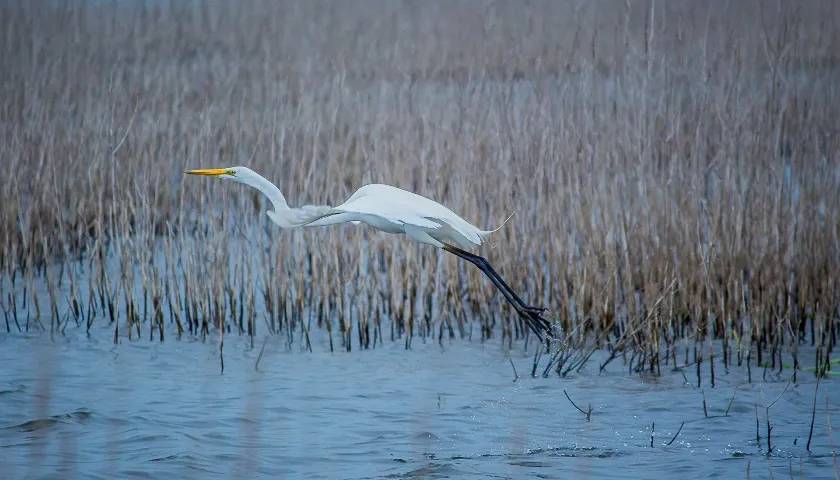
Nagarhole National Park, ranked 10th, is a key component of the Nilgiri Biosphere Reserve in Karnataka. This park is renowned for its lush deciduous forests, swamps, and the serene Kabini River, which create a thriving habitat for a wide array of wildlife. It is one of the premier tiger reserves in India, offering visitors the chance to see these majestic cats along with leopards, elephants, and Indian bison. Nagarhole is also a haven for birdwatchers, boasting over 270 species of birds. The park's well-maintained safari trails and effective conservation programs enhance the wildlife viewing experience. The combination of diverse fauna, picturesque landscapes, and robust conservation efforts secures Nagarhole National Park the 10th rank on our list.
Flora at Nagarhole National Park: Nagarhole National Park, located in Karnataka, is renowned for its rich and diverse flora, characteristic of the Western Ghats. The park's landscape includes tropical and subtropical moist broadleaf forests, mixed deciduous forests, and grassy swamps. The dominant tree species in Nagarhole are teak, rosewood, sandalwood, and silver oak, interspersed with bamboo groves and tall grasses. The Kabini River and its tributaries flow through the park, creating a network of waterways that support a lush riparian ecosystem. Nagarhole's varied habitats provide essential food and shelter for its diverse wildlife population, contributing to its status as a biodiversity hotspot.
Fauna at Nagarhole National Park: Nagarhole National Park is celebrated for its impressive wildlife diversity, including a healthy population of tigers and elephants. Other notable species found here include Indian bison (gaur), leopards, sloth bears, dholes (Indian wild dogs), and various deer species such as sambar, chital, and barking deer. The park's water bodies attract a variety of water birds and aquatic species, while its dense forests are home to numerous bird species, making it a paradise for birdwatchers. Nagarhole's well-maintained safari trails and effective conservation efforts ensure memorable wildlife encounters amidst its picturesque landscapes.
Best time to visit Nagarhole National Park: The best time to visit Nagarhole National Park is from October to May. During this period, the weather is pleasant, and the forest is lush post-monsoon, enhancing the wildlife viewing experience. The cooler months from November to February are particularly ideal, as animals are more active and often spotted near water sources. Additionally, this time of year is excellent for birdwatching, with numerous migratory species visiting the park. The summer months of March to May, although warmer, provide excellent opportunities for spotting wildlife around the shrinking water bodies. It is advisable to avoid the monsoon season (June to September) when heavy rainfall can lead to park closures and make safaris difficult due to muddy conditions.
Safari timings at Nagarhole National Park:
Daily Safaris: Monday / Tuesday / Wednesday / Thursday / Friday / Saturday / Sunday
- Morning Safari: 6:00 am - 8:00 am
- Evening Safari: 3:00 pm - 5:00 pm
9. Tadoba National Park, Maharashtra

Tadoba National Park, ranked 9th, is one of Maharashtra's premier wildlife sanctuaries, often referred to as the "Jewel of Vidarbha." Known for its thriving tiger population, the park offers some of the best opportunities for tiger sightings in India. Tadoba's diverse landscape includes dense teak and bamboo forests, open grasslands, and serene lakes, creating a perfect habitat for a variety of wildlife, including leopards, sloth bears, and Indian bison. The park is also a haven for bird enthusiasts, with over 200 species of birds. Tadoba's excellent conservation efforts, combined with well-organized safari experiences, ensure an unforgettable encounter with nature. Its rich biodiversity and remarkable success in wildlife preservation secure Tadoba National Park the 9th rank on our list.
Flora at Tadoba National Park: Tadoba National Park, located in Maharashtra, features a diverse range of flora typical of the central Indian landscape. The park's vegetation includes dense teak forests, mixed deciduous forests, and bamboo groves, interspersed with open grasslands and seasonal streams. Other prominent tree species found in Tadoba include mahua, ain, semal, and jamun. The park's varied habitats support a rich array of plant life, adapted to thrive in the region's tropical and dry deciduous climate. During the monsoon season, the park transforms into a lush green paradise, providing ample forage and shelter for its diverse wildlife population.
Fauna at Tadoba National Park: Tadoba National Park is renowned for its impressive wildlife diversity, most notably its thriving population of Bengal tigers. Besides tigers, the park is home to leopards, sloth bears, Indian bison (gaur), sambar deer, chital (spotted deer), and wild dogs (dholes). Tadoba's numerous water bodies, including the Tadoba Lake and several seasonal ponds, support a variety of aquatic species, including marsh crocodiles and various waterfowl. The park is also a haven for birdwatchers, with over 195 species of birds recorded, including endangered species like the grey-headed fish eagle and the lesser adjutant. Tadoba's rich biodiversity and successful conservation efforts make it a premier destination for wildlife enthusiasts seeking memorable encounters with India's iconic wildlife.
Best time to visit Tadoba National Park: The best time to visit Tadoba National Park is from October to June, with each season offering unique wildlife experiences. The winter months from November to February provide pleasant weather, making it ideal for safaris and outdoor activities. Wildlife is often more active during this period, and the cooler temperatures make the experience more comfortable. The summer months of March to June, although hotter, are excellent for wildlife sightings, especially around water sources as animals gather to quench their thirst. This period increases the chances of spotting tigers and other large mammals. It is advisable to avoid the monsoon season (July to September) when heavy rainfall can lead to park closures and make safaris challenging due to muddy conditions.
Safari timings at Tadoba National Park:
Daily Safaris: Monday / Tuesday / Wednesday / Thursday / Friday / Saturday / Sunday
October 1st to November 30th:
- Morning Safari: 6:00 AM to 8:00 AM, exit by 10:00 AM
- Afternoon Safari: 2:30 PM to 4:00 PM, exit by 6:30 PM
December 1st to February 28th/29th: (Peak Season)
- Morning Safari: 6:30 AM to 8:30 AM, exit by 11:00 AM
- Evening Safari: 2:00 PM to 3:30 PM, exit by 6:00 PM
March 1st to June 30th: (Shoulder Season)
- Morning Safari: 5:00 AM to 7:00 AM, with an exit by 9:30 AM.
- Evening Safari: 3:30 PM to 5:00 PM, with an exit by 7:00 PM.
8. Bandipur National Park, Karnataka

Bandipur National Park, ranked 8th, is a significant wildlife sanctuary within Karnataka and an integral part of the Nilgiri Biosphere Reserve. Known for its extensive tiger population, Bandipur also supports a rich array of wildlife, including elephants, leopards, and various species of deer. The park's diverse habitats range from dry deciduous forests to open grassy woodlands, making it a biodiversity hotspot. Bandipur's conservation efforts are notable, contributing significantly to Project Tiger's success in India. The park's proximity to major cities like Bangalore and Mysore, along with its well-maintained safari infrastructure, makes it a popular destination for wildlife enthusiasts. The combination of ecological importance, thriving wildlife, and accessibility justifies Bandipur National Park's 8th rank on our list.
Flora at Bandipur National Park: Bandipur National Park, situated in the southern part of Karnataka, boasts a rich and diverse array of flora. The park is predominantly covered with dry deciduous forests, interspersed with moist deciduous and scrub forests, creating a mosaic of lush greenery. Key tree species include teak, rosewood, sandalwood, Indian laurel, and giant clumping bamboo. The park's undergrowth is dense with shrubs, grasses, and medicinal plants, which provide essential cover and food sources for the wildlife. The seasonal variations bring a unique charm to the park's vegetation, with blooming flowers in the post-monsoon period adding vibrant colors to the landscape. This diverse flora not only enhances the aesthetic appeal of Bandipur but also supports a wide range of animal species by providing crucial habitat and sustenance.
Fauna at Bandipur National Park: The fauna of Bandipur National Park is renowned for its diversity and abundance, making it one of the premier wildlife sanctuaries in India. The park is a part of the Nilgiri Biosphere Reserve, which is a critical habitat for numerous endangered and endemic species. Notable residents include tigers, leopards, elephants, and Indian bison (gaur), which roam the forests in significant numbers. Other mammals such as spotted deer, sambar, four-horned antelope, and wild boar are commonly sighted. The park is also a haven for bird enthusiasts, with over 200 species of birds, including the Indian roller, crested serpent eagle, and Malabar trogon. Reptiles, such as Indian rock pythons and various lizards, are also prevalent. The rich variety of fauna in Bandipur makes it a vital area for wildlife conservation and a fascinating destination for nature lovers and wildlife photographers.
Best time to visit Bandipur National Park: The prime time to visit Bandipur National Park is between October and March. This winter window offers pleasant weather, perfect for exploring, and coincides with increased wildlife activity. As summer heats up from March to May, animals gather around shrinking waterholes, making sightings more likely. However, the park can get quite hot. The monsoon season from June to September sees the park closed, but the lush greenery returns upon reopening.
Safari timings at Bandipur National Park: Daily Safaris: Monday / Tuesday / Wednesday / Thursday / Friday / Saturday / Sunday
Bus Safari: Timings can vary slightly depending on the season, but they are generally offered in the following slots.
- Morning: 6:15 AM to 7:45 AM, 7:45 AM to 9:30 AM
- Evening: 2:30 PM to 4:00 PM, 4:00 PM to 5:30 PM
Jeep Safari: Similar to bus safaris, timings can vary based on the season, but they typically run in these slots.
- Morning: 6:00 AM to 9:00 AM
- Evening: 3:00 PM to 6:00 PM
7. Kanha National Park, Madhya Pradesh
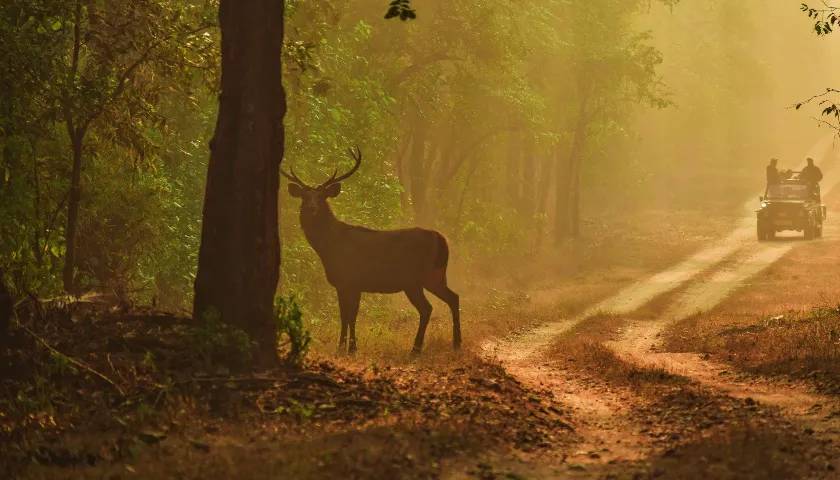
Kanha National Park, ranked 7th, is one of India's most celebrated wildlife sanctuaries, renowned for its vast landscapes, rich biodiversity, and successful conservation programs. Spanning over 940 square kilometers, the park's lush sal and bamboo forests, rolling meadows, and serene streams create an ideal habitat for a diverse range of wildlife. Kanha is particularly famous for its significant tiger population and the successful revival of the hardground barasingha, an endangered species of swamp deer. This park also served as the inspiration for Rudyard Kipling's classic, "The Jungle Book," adding a legendary allure to its natural beauty. Kanha's well-maintained safari trails and dedicated conservation efforts ensure an exceptional wildlife viewing experience, securing its position as the 7th ranked national park on our list.
Flora at Kanha National Park: Kanha National Park, located in Madhya Pradesh, boasts a diverse and lush vegetation typical of the central Indian highlands. The park's landscape is dominated by sal and bamboo forests, interspersed with extensive grasslands and meadows. Other prominent tree species include mahua, jamun, arjun, and banyan, creating a varied and rich habitat. The Banjaar River meanders through the park, enhancing its scenic beauty and supporting a thriving riparian ecosystem. Kanha's flora undergoes seasonal changes, with lush greenery during the monsoon and golden hues in the dry season, providing essential food and shelter for its diverse wildlife population.
Fauna at Kanha National Park: Kanha National Park is renowned for its remarkable biodiversity and as the inspiration for Rudyard Kipling's classic, "The Jungle Book." The park is home to a significant population of Bengal tigers, as well as leopards, Indian wild dogs (dholes), sloth bears, and Indian bison (gaur). Kanha's diverse habitats, including dense forests, open grasslands, and water bodies, support a wide variety of herbivores such as chital (spotted deer), sambar deer, barasingha (swamp deer), and barking deer. The park's rich avifauna includes over 300 species of birds, including the majestic Indian peafowl, endangered species like the bar-headed goose, and migratory birds during the winter months. Kanha National Park's well-organized safaris and effective conservation efforts ensure a memorable wildlife experience amidst its scenic landscapes.
Best time to visit Kanha National Park: The best time to visit Kanha National Park is from October to April. During this period, the weather is cooler and more pleasant, making it ideal for wildlife safaris and outdoor activities. The vegetation is less dense, improving visibility for spotting animals, especially tigers and other large mammals. The winter months from November to February are particularly favorable, as animals are more active during the day and often seen near water sources. Additionally, this time coincides with the migratory bird season, enhancing the park's biodiversity and offering excellent opportunities for birdwatching. It's advisable to avoid the monsoon season (July to September) when heavy rainfall can lead to park closures and make safaris challenging due to muddy conditions.
Safari timings at Kanha National Park:
Daily Safaris: Monday / Tuesday / Wednesday / Thursday / Friday / Saturday / Sunday
- Morning Safari: 6:00 am - 11:00 am
- Evening Safari: 3:00 pm - 6:00 pm
6. Kaziranga National Park, Assam
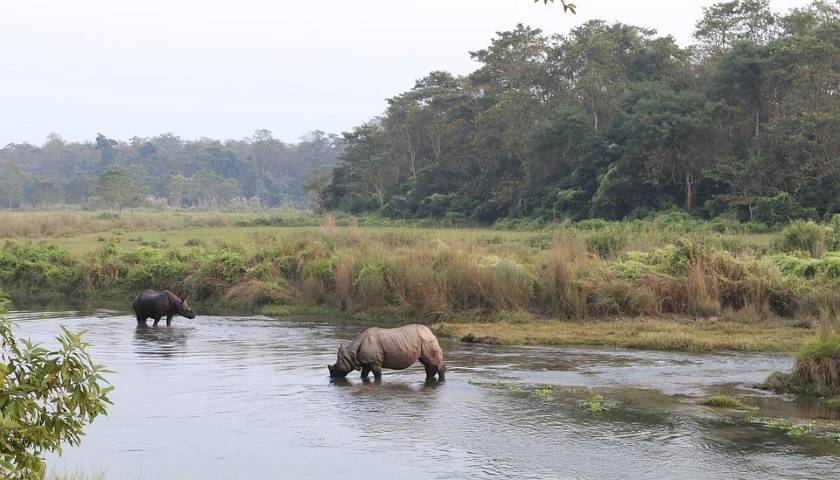
Kaziranga National Park, ranked 6th, is a UNESCO World Heritage Site renowned for its extraordinary conservation success and the largest population of the Indian one-horned rhinoceros. Located in Assam, the park's diverse habitats, including tall elephant grass, marshlands, and dense tropical forests, support a rich array of wildlife. Besides rhinos, Kaziranga is home to significant populations of tigers, elephants, wild water buffalo, and swamp deer, making it a critical sanctuary for these species. The park also boasts an impressive variety of birdlife, attracting birdwatchers from around the globe. Kaziranga's effective anti-poaching measures and robust conservation programs have made it a model of wildlife preservation. The park's unparalleled biodiversity and successful conservation strategies rightfully earn it the 6th rank on our list.
Flora at Kaziranga National Park: Kaziranga National Park, located in Assam, is renowned for its unique and diverse flora, shaped by its distinct ecosystems. The park primarily consists of tall elephant grass, marshlands, and dense tropical forests interspersed with shallow pools and seasonal floodplains. The dominant tree species include Indian rosewood, cotton tree, and elephant apple, along with various species of orchids and climbers. The park's vegetation is well-adapted to the region's seasonal flooding, creating a dynamic landscape that supports a rich variety of wildlife. During the dry season, the grasslands provide vital grazing grounds for herbivores, while the dense forests offer shelter and nesting sites for birds and mammals alike.
Fauna at Kaziranga National Park: Kaziranga National Park is celebrated for its extraordinary biodiversity and as a UNESCO World Heritage Site. The park is most famous for its population of the Indian one-horned rhinoceros, which constitutes a significant proportion of the global population. Kaziranga is also home to the Bengal tiger, Asian elephant, wild water buffalo, and swamp deer. The park's wetlands and water bodies host a variety of aquatic species, including the endangered Ganges river dolphin and numerous species of fish and turtles. Kaziranga is a paradise for birdwatchers, with over 500 species of birds recorded, including migratory birds from Central Asia and Siberia during the winter months. The park's effective conservation efforts and successful habitat management make it a model for wildlife preservation in India.
Best time to visit Kaziranga National Park: The best time to visit Kaziranga National Park is from November to April. During this period, the weather is pleasant and dry, making it ideal for wildlife safaris and outdoor activities. The winter months from November to February are particularly favorable, as the weather is cooler and animals are more active during the day. This time also coincides with the peak season for birdwatching, with numerous migratory birds visiting the park. The dry season (March-April) is excellent for wildlife sightings, as animals congregate around water sources, which are limited due to the receding floodwaters. It is advisable to avoid the monsoon season (June to September) when heavy rains lead to flooding and park closures, making safaris challenging.
Safari timings at Kaziranga National Park:
Jeep Safaris: Monday / Tuesday / Wednesday / Thursday / Friday / Saturday / Sunday
- Morning Safari: 7:00 am - 9:00 am
- Evening Safari: 1:30 pm - 3:30 pm
Elephant Safaris: Monday / Tuesday / Wednesday / Thursday / Friday / Saturday / Sunday
- Morning Safari: 5:15 am - 6:15 am, and 6:15 AM - 7:15 AM.
5. Gir National Park, Gujarat

Gir National Park in Gujarat, ranked 5th, is world-renowned as the last refuge of the Asiatic lion. This park's rugged hills, mixed deciduous forests, and savannah-type grasslands provide a unique and suitable habitat for these majestic lions. Besides its star attraction, Gir is home to a rich diversity of wildlife, including leopards, sambar deer, chital, nilgai, and over 300 species of birds. The park's perennial rivers and water bodies support a variety of aquatic species, adding to its ecological richness. Gir's successful conservation efforts have significantly increased the population of Asiatic lions, drawing wildlife enthusiasts from across the globe. The park's well-regulated safaris, combined with its distinctive landscape and thriving wildlife, secure Gir National Park the 5th rank on our list.
Flora at Gir National Park: Gir National Park, located in Gujarat, is renowned for its unique and diverse flora, adapted to the semi-arid and dry deciduous forests of western India. The park's landscape is dominated by scrubland, teak forests, and patches of grasslands interspersed with rocky hills and valleys. The vegetation includes species such as acacia, flame of the forest, jamun, dhak, and a variety of grasses and shrubs. Gir's flora is well-adapted to withstand the region's hot and dry climate, providing essential food and shelter for its diverse wildlife population.
Fauna at Gir National Park: Gir National Park is celebrated as the last refuge of the Asiatic lion and is home to a significant population of these majestic big cats. Besides lions, the park supports a rich variety of wildlife, including leopards, sloth bears, Indian gazelles (chinkara), and wild boars. The park's diverse habitats, including dense forests, grasslands, and rocky hills, provide ideal conditions for a variety of bird species, including the endangered white-rumped vulture and Indian paradise flycatcher. Gir's successful conservation efforts and effective management strategies have ensured the survival of the Asiatic lion and other endangered species, making it a premier destination for wildlife enthusiasts and conservationists alike.
Best time to visit Gir National Park: The best time to visit Gir National Park is from December to April. During this period, the weather is pleasant and dry, making it ideal for wildlife safaris and outdoor activities. The winter months from December to February are particularly favorable, as the weather is cooler and animals are more active during the day. This time also coincides with the peak season for lion sightings, as they are often seen basking in the sun or near water bodies. The dry season (March-April) is excellent for wildlife sightings, as vegetation is sparse and animals are easily spotted around water sources. It is advisable to avoid the monsoon season (June to September) when heavy rains lead to flooding and park closures, making safaris challenging.
Safari timings at Gir National Park:
Daily Safaris: Monday / Tuesday / Wednesday / Thursday / Friday / Saturday / Sunday
- Morning Safari: 7:00 am - 10:55 am
- Evening Safari: 3:00 pm - 5:55 pm
4. Corbett National Park, Uttarakhand
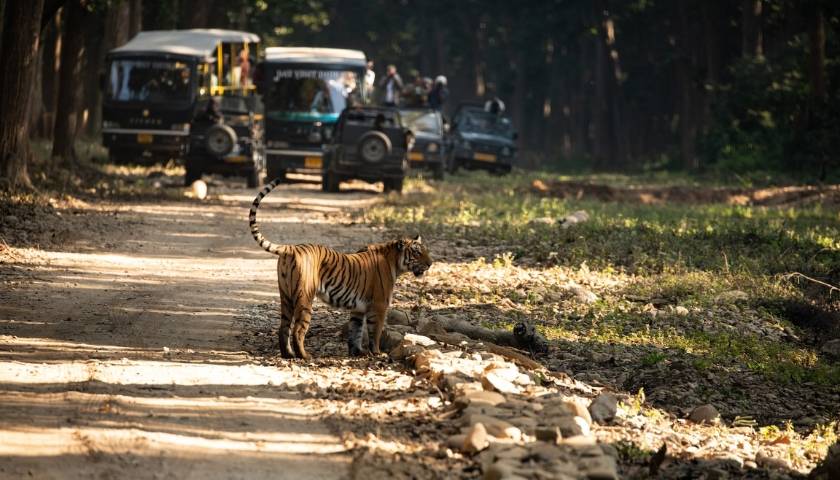
Corbett National Park in Uttarakhand, ranked 4th, is celebrated as India's first national park and a pioneering project under the country's tiger conservation initiative, Project Tiger. Established in 1936, the park boasts a rich variety of landscapes, including dense forests, grasslands, riverine belts, and the picturesque Ramganga River. Corbett is renowned for its substantial population of Bengal tigers, alongside other wildlife such as leopards, elephants, Himalayan black bears, and over 600 species of birds. The park's diverse flora, ranging from sal and oak trees to bamboo thickets, creates an ideal habitat for this abundant wildlife. Corbett's scenic beauty, combined with its historical significance and successful conservation efforts, offers a unique and enriching experience for visitors, rightly securing it the 4th rank on our list.
Flora at Corbett National Park: Corbett National Park, located in Uttarakhand, encompasses a diverse range of flora typical of the Himalayan foothills and the Terai region. The park's landscape includes dense moist deciduous forests, mixed forests of sal and sheesham, and open grasslands interspersed with riverine belts and marshy depressions. The vegetation is rich and varied, featuring over 488 species of plants, including trees like sal, khair, sissoo, and bamboo. The Ramganga River and its tributaries flow through the park, enhancing its biodiversity and supporting a thriving riparian ecosystem. Corbett's flora undergoes seasonal changes, with lush greenery during the monsoon and dry deciduous foliage in the winter, providing essential food and shelter for its diverse wildlife population.
Fauna at Corbett National Park: Corbett National Park is renowned for its impressive biodiversity and as the first national park in India to come under the Project Tiger initiative. The park is home to a wide variety of wildlife, including Bengal tigers, leopards, elephants, sloth bears, and several species of deer such as chital, sambar, and hog deer. The park's rivers and water bodies support a variety of aquatic species, including the endangered gharial and mugger crocodiles, and over 600 species of birds, making it a paradise for birdwatchers. Corbett's varied habitats, ranging from dense forests to grasslands and riverine belts, provide ideal conditions for a rich and diverse wildlife population, ensuring a memorable wildlife experience amidst its scenic landscapes.
Best time to visit Corbett National Park: The best time to visit Corbett National Park is from November to June. During this period, the weather is pleasant and dry, making it ideal for wildlife safaris and outdoor activities. The winter months from November to February are particularly favorable, as the weather is cooler and animals are more active during the day, increasing the chances of wildlife sightings. The spring months of March to June offer excellent opportunities for birdwatching and observing wildlife around water sources, as vegetation begins to dry up, making animals more visible. It is advisable to avoid the monsoon season (July to September) when heavy rainfall can lead to park closures and make safaris challenging due to muddy conditions.
Safari timings at Corbett National Park:
Daily Safaris: Monday / Tuesday / Wednesday / Thursday / Friday / Saturday / Sunday
- Morning Safari: 6:00 am - 9:30 am
- Evening Safari: 3:00 pm - 6:00 pm
3. Sundarbans National Park, West Bengal
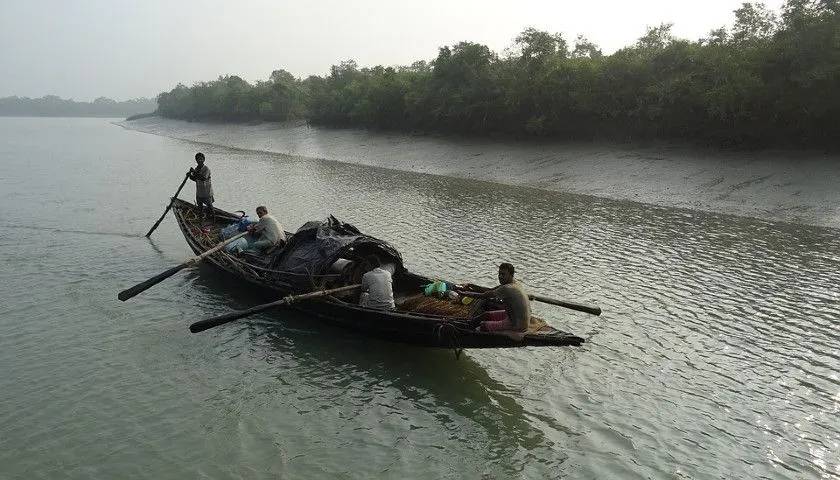
Sundarbans National Park, ranked 3rd, is a unique and vital wildlife sanctuary located in West Bengal. As the largest mangrove forest in the world and a UNESCO World Heritage Site, Sundarbans is renowned for its extraordinary biodiversity and critical conservation efforts. The park is most famous for its Bengal tigers, which have adapted to an amphibious lifestyle, swimming between the islands of the delta. Besides tigers, Sundarbans is home to a variety of wildlife, including spotted deer, saltwater crocodiles, and numerous bird species. The intricate network of tidal waterways, mudflats, and small islands creates a complex and fascinating ecosystem that supports a wide range of flora and fauna. The park's importance in protecting these unique habitats and its role in the survival of the Bengal tiger population make Sundarbans National Park a significant and captivating destination, justifying its high rank on our list.
Flora at Sundarbans National Park: Sundarbans National Park, located in West Bengal, is renowned for its unique and biodiverse flora adapted to its tidal mangrove ecosystem, the largest of its kind in the world. The park's landscape is dominated by dense mangrove forests, comprising species such as sundari (Heritiera fomes), goran (Ceriops decandra), and gewa (Excoecaria agallocha). These mangrove species are well-adapted to survive in saline and brackish water conditions, creating a labyrinth of interlacing roots and mudflats that serve as a crucial habitat for numerous wildlife species. Sundarbans' flora plays a vital role in stabilizing coastal areas, protecting against erosion, and providing food and shelter for its diverse fauna.
Fauna at Sundarbans National Park: Sundarbans National Park is renowned for its rich and unique fauna, most notably the Bengal tiger that has adapted to a semi-aquatic lifestyle in the mangrove swamps. The park is also home to other iconic species such as saltwater crocodiles, spotted deer, wild boars, and rhesus macaques. The mangrove forests and tidal waterways support a variety of aquatic species, including endangered species like the Irrawaddy dolphin and numerous fish species. Sundarbans is a haven for birdwatchers, with over 260 bird species recorded, including migratory birds during the winter months. The park's biodiversity, coupled with its distinctive mangrove ecosystem, makes Sundarbans National Park a globally significant and captivating destination for wildlife enthusiasts and conservationists alike.
Best time to visit Sundarbans National Park: The best time to visit Sundarbans National Park is from December to February. During this period, the weather is pleasant and dry, making it ideal for wildlife safaris and exploring the mangrove forests. The winter months from December to February are particularly favorable, as the weather is cooler and more comfortable for outdoor activities. This time also coincides with the peak season for birdwatching, with numerous migratory bird species visiting the park. It's advisable to avoid the monsoon season (June to September) when heavy rainfall and strong winds can create challenging conditions, including flooding and limited access to certain areas of the park.
Safari timings at Sundarbans National Park:
Daily Safaris: Monday / Tuesday / Wednesday / Thursday / Friday / Saturday / Sunday
- Boat Safari: 8:00 am - 4:00 pm
2. Bandhavgarh National Park, Madhya Pradesh
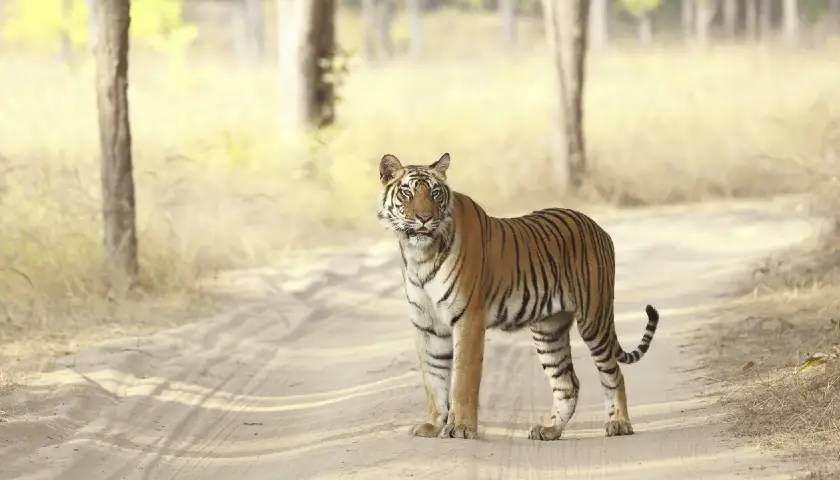
Bandhavgarh National Park in Madhya Pradesh, ranked 2nd, is renowned for having one of the highest densities of Bengal tigers in the world, making it a premier destination for tiger enthusiasts. The park's dramatic terrain features steep ridges, undulating hills, and dense forests interspersed with grasslands and bamboo thickets. Historical relics, including ancient caves and the majestic Bandhavgarh Fort, add a unique cultural dimension to the park's natural beauty. Besides tigers, Bandhavgarh is home to a rich variety of wildlife, including leopards, sloth bears, deer, and over 250 bird species. The park's effective conservation practices and well-regulated safari experiences ensure visitors can witness its incredible biodiversity in a sustainable manner. The combination of exceptional wildlife viewing, stunning landscapes, and historical significance justifies Bandhavgarh National Park's high ranking on our list.
Flora at Bandhavgarh National Park: Bandhavgarh National Park, nestled in the Vindhya Hills of Madhya Pradesh, boasts a rich and diverse flora typical of the central Indian highlands. The park's landscape comprises tropical moist deciduous forests interspersed with grasslands, rocky hills, and perennial streams. The dominant tree species include sal, saj, saja, dhobin, and bamboo, creating a varied habitat that supports a wide range of wildlife. Bandhavgarh's flora undergoes seasonal changes, with lush greenery during the monsoon and dry deciduous foliage in the winter, providing essential food and shelter for its diverse fauna.
Fauna at Bandhavgarh National Park: Bandhavgarh National Park is renowned for its impressive biodiversity and as one of the best places to spot Bengal tigers in India. Besides tigers, the park is home to a thriving population of leopards, sloth bears, Indian bison (gaur), sambar deer, and spotted deer. The park's varied habitats, including dense forests, grasslands, and water bodies, support a rich avifauna with over 250 species of birds recorded, including migratory species during the winter months. Bandhavgarh's effective conservation efforts and well-organized safaris ensure a memorable wildlife experience amidst its scenic landscapes.
Best time to visit Bandhavgarh National Park: The best time to visit Bandhavgarh National Park is from October to June. During this period, the weather is pleasant and conducive for wildlife safaris and outdoor activities. The winter months from November to February are particularly favorable, as the weather is cooler and animals are more active during the day, increasing the chances of tiger sightings. The spring months of March to June offer excellent opportunities for birdwatching and observing wildlife around water bodies as vegetation begins to dry up. It is advisable to avoid the monsoon season (July to September) when heavy rainfall can lead to park closures and make safaris challenging due to muddy conditions.
Safari timings at Bandhavgarh National Park:
Daily Safaris: Monday / Tuesday / Thursday / Friday / Saturday / Sunday
Morning Hours
- 15th October to 15th Feb - 06:30 Am to 11:00 Am.
- 16th Feb to 31st March - 06:00 Am to 11:00 Pm.
- 01st April to 30th June - 05:30 Am to 10:00 Pm.
Afternoon Hours
- 15th October to 15th Feb - 14:30 Pm to 17:30 Pm.
- 16th Feb to 31st March - 15:00 Pm to 18:00 Pm.
- 01st April to 30th June - 16:00 Pm to 19:00 Pm.
1. Ranthambore National Park, Rajasthan
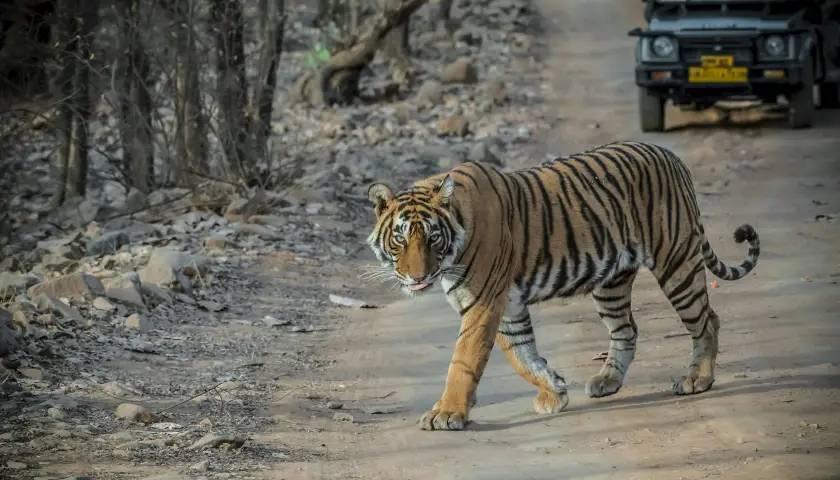
Ranthambore National Park in Rajasthan, ranked 1st, stands out as the premier wildlife sanctuary in India due to its exceptional tiger sightings, rich biodiversity, and captivating history. Spread over 1,334 square kilometers, the park's diverse terrain includes dry deciduous forests, grassy meadows, and the serene lakes of Padam Talao and Malik Talao. The ancient Ranthambore Fort, perched on a hilltop within the park, adds a majestic historical backdrop to the wildlife experience. Ranthambore is renowned for its relatively high tiger population, offering some of the best opportunities to see these magnificent predators in their natural habitat. Besides tigers, the park is home to leopards, sloth bears, sambar deer, and over 300 species of birds. The park's well-managed safari system and dedicated conservation efforts ensure an enriching and sustainable experience for all visitors. This combination of prolific wildlife, striking landscapes, and historical intrigue firmly establishes Ranthambore National Park as the top choice on our list.
Flora at Ranthambore National Park: Ranthambore National Park, located in Rajasthan, features a diverse and rugged terrain typical of the Aravalli and Vindhya hill ranges. The park's landscape includes dry deciduous forests, open grasslands, and rocky outcrops interspersed with several lakes and perennial streams. The dominant vegetation consists of dhok trees, mango trees, babul, and various species of acacia. Ranthambore's flora is well-adapted to the arid climate of Rajasthan, with vegetation that undergoes seasonal changes, from lush greenery during the monsoon to dry foliage in the winter. The park's varied habitats provide essential food and shelter for its rich wildlife population.
Fauna at Ranthambore National Park: Ranthambore National Park is renowned for its impressive biodiversity and as one of the best places in India to spot Bengal tigers in their natural habitat. Besides tigers, the park is home to a variety of wildlife including leopards, striped hyenas, sloth bears, sambar deer, chital, and wild boars. The park's numerous lakes and water bodies support a rich diversity of aquatic species, including marsh crocodiles and numerous species of turtles and fish. Ranthambore is also a paradise for birdwatchers, with over 300 species of birds recorded, including migratory birds during the winter months. The park's rugged landscapes, historical ruins, and effective conservation efforts make it a premier destination for wildlife enthusiasts and photographers alike.
Best time to visit Ranthambore National Park: The best time to visit Ranthambore National Park is from October to April. During this period, the weather is pleasant and dry, making it ideal for wildlife safaris and outdoor activities. The winter months from November to February are particularly favorable, as the weather is cooler and animals are more active during the day, increasing the chances of tiger sightings. The spring months of March to April offer excellent opportunities for birdwatching and observing wildlife around water bodies as vegetation begins to dry up. It is advisable to avoid the summer months (May to June) when temperatures can soar, making wildlife sightings less frequent and the heat uncomfortable for prolonged outdoor activities.
Safari timings at Ranthambore National Park:
Daily Safaris: Monday / Tuesday / Wednesday / Thursday / Friday / Saturday / Sunday
- October 1st to October 31st - Morning 6.30 am to 10.00 am, and Afternoon 2.30 pm to 6.00 pm.
- November 1st to January 31st - Morning 7.00 am to 10.30 am and Afternoon 2.00 pm to 5.30 pm.
- February 1st to March 31st - Morning 6.30 am to 10.00 am and Afternoon 2.30 pm to 6.00 pm.
- April 1st to May 15th - Morning 6.00 am to 9.30 am and Afternoon 3.00 pm to 6.30 pm.
- May 16th to June 30th - Morning 6.00 am to 9.30 am and Afternoon 3.30 pm to 7.00 pm.






